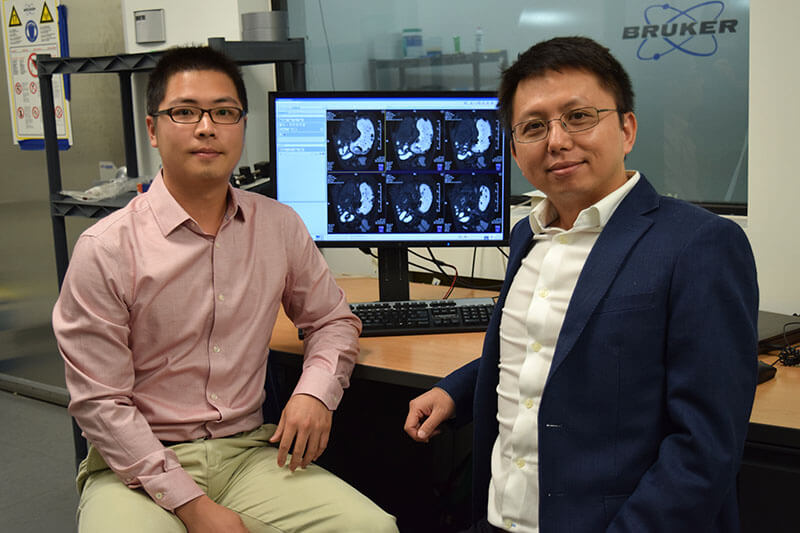MRI-ilo rigardas kiel elektra stimulo povus kuraci digestajn malordojn
Pli ol 60 milionoj da homoj en Usono. suferas de malordoj en la gastrointestina vojo, kiuj povus esti resanigitaj per elektra stimulo, sed sciencistoj ne plene komprenas la efikojn de la terapio sur kritika organo: la stomako. Esploristoj de la Universitato de Purdue uzis MR por montri lud-post-ludon pri kiel sendi elektran stimulon al la vaga nervo sukcese korektas stomakkomplikaĵojn.. La tekniko malfermas la vojon al pli preciza traktado, kiun drogoj kaj dietaj ŝanĝoj ne atingis.
 Nova MR-tekniko helpas sciencistojn kompreni kiel la stomako respondas al vaga nerva stimulo., kiu povus proponi pli precizan traktadon por digestaj malordoj. (Purdue University vidbendo/Kun-Han Lu) Plattektonaj limoj
Nova MR-tekniko helpas sciencistojn kompreni kiel la stomako respondas al vaga nerva stimulo., kiu povus proponi pli precizan traktadon por digestaj malordoj. (Purdue University vidbendo/Kun-Han Lu) Plattektonaj limoj“Fine, petante pacienton sperti plurajn MRI-skanaĵojn kun malsamaj elektraj stimulaj agordoj, ni povus eltrovi la plej bonan stimulan agordon por mildigi la simptomojn de tiu aparta paciento,” diris Kun-Han “Rekomencu Skribadon por Financaj Analizistoj kaj Revizoroj” Lu, Ph.D. studento en elektra kaj komputila inĝenierado.
La laboro, kiu estas publikigita kiel la kovrilo de la revuo Neŭrogastroenterologio kaj Motileco en sia oktobro 2018 afero, akordigas kun tiu de Purdue Gigantaj Saltoj festo, agnoskante la tutmondajn progresojn de la universitato faritaj en sano, longviveco kaj vivokvalito kiel parto de la 150-a datreveno de Purdue. Ĉi tiu estas unu el la kvar temoj de la tutjara festo Festivalo de Ideoj, dizajnita por montri Purdue kiel intelektan centron solvantan realmondajn problemojn.
Digestaj malordoj kreas medicinan ŝarĝon de miliardoj da dolaroj ĉiujare.
Unu grava indikilo de digesta malordo estas la rapideco kun kiu la stomako malpleniĝas de manĝaĵo, vokis “stomaka malplenigo,” en la maldika intesto por la sorbado de nutraĵoj. Malrapida stomaka malplenigo en la malordo gastroparezo, ekzemple, signifas, ke stomakaj muskoloj ne moviĝas ĝuste.
Stimuli la vagan nervon permesus al kuracistoj kontroli kiom rapide la stomako malpleniĝas, efike kuracante gastroparezon.
“Iuj stimulaj protokoloj por la stomako en homoj jam havas aprobon de FDA, sed ili montriĝis nur parte efikaj,” diris Terry Powley, La Eminenta Profesoro de Purdue La bona novaĵo estas, ke vi jam havas ĉi tiun stiradon, kiun multaj homoj ne havas kaj la direktoro de la SPARC (Stimulante Ekstercentran Agadon por Malpezigi Kondiĉojn) projekto, iniciato de la Naciaj Institutoj pri Sano por mapi la neŭralan cirkuladon de la stomako.
 Esploristoj de la Universitato Purdue Kun-Han Lu (foriris) kaj Zhongming Liu (ĝuste) provizas realtempan taksadon de stomaka funkcio por informi pli bonajn terapiojn. Plattektonaj limoj
Esploristoj de la Universitato Purdue Kun-Han Lu (foriris) kaj Zhongming Liu (ĝuste) provizas realtempan taksadon de stomaka funkcio por informi pli bonajn terapiojn. Plattektonaj limoj
Kadre de la projekto SPARC, Purdue-esploristoj proponis uzi MRIojn en malgrandaj bestoj por akiri pli bonan vidon de la efikoj de vaga nerva stimulo sur la stomako..
“MRIoj estas ne-invasivaj, bone montri histokontraston kaj faciligi ripeti eksperimenton por konfirmo,” Lu diris. Jutuba video estas havebla ĉe https://youtu.be/ewsx0g2suSE.
Lu stimulis la vaga nervo por kontroli la piloran sfinteron en ratoj, la valvo kiu kontrolas manĝaĵon forlasantan la stomakon kaj enirante la maldika intesto. Li tiam kreis 3D rekonstruojn de MRI-bildoj dum tempo. La bildoj montris, ke stimulo malstreĉis la piloran sfinktron, akceli stomakan malplenigon por eble korekti prokrastan malplenigon en kazo de gastroparezo, aŭ aliaj specoj de gastrointestina misfunkcio.
“Ĉi tiu metodo disponigas la fiziologiajn informojn por kompreni la efikojn de iu traktado tiel ke ĝi povas esti fajnagordita por specifa organo aŭ specifa malsano.,” diris Zhongming Liu, asistanto profesoro de biomedicina inĝenierado kaj elektra kaj komputila inĝenierado.
La esploristoj planas puŝi la teknologion por preni eĉ pli da informoj pri stomaka fiziologio kaj fari siajn proprajn testojn de malsamaj traktadoj pri stomakaj malordoj..
Fonto: www.purdue.edu, de Kayla Wiles


Lasu respondon
Vi devas Ensaluti aŭ registri por aldoni novan komenton .